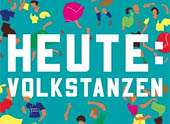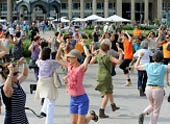PROJECTS
> Documentation 2012

DÉBORDS. Reflections on the Green Table
Olga de Soto’s award-winning documentary/choreographic research showed how Kurt Jooss’s anti-war piece Der Grüne Tisch (The Green Table) enthused and influenced people around the world.
The Source Code
Jochen Roller’s online-project is dedicated to the choreographer Gertrud Bodenwieser who emigrated to Australia in 1938. It features reconstructions, archive material and reports by contemporary witnesses.
HEUTE: volkstanzen
Four choreographers investigated parallels between folk dance and popular contemporary dances. A major folk-dance festival invited participants to dance and reflect on the theme.
DANCE OF ALL – A MOVEMENT CHOIR
For the Tanz Aller project, the artist group Ligna used the radio-ballet concept to revive the political movement choirs of the 1920s with members of the public.
Auch
Reinhild Hoffmann’s 1980 choreography Auch, in which two women dance a duet on a fully equal footing, caused a sensation when first performed. Hoffmann restaged the production at Theater Bielefeld herself.
Dancing Bauhaus
Oskar Schlemmer’s Bauhaus Dances – created from 1926 to 1929 – were re-interpreted with students from the Anhaltisches Theater Dessau and the Inter-university Center for Dance (HZT) Berlin.
SACHAROFF RESEARCH PROJECT
Stella Tinbergen’s documentary film Poets of Dance reveals the life and works of the famous dance couple Clotilde and Alexander Sacharoff and includes a reconstruction of their dances.

